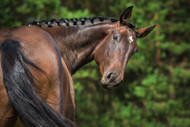Pinworm In Horses
Posted by Darren Walton on 16th Jan 2023
Among the most efficient of all horse parasites, Pinworm have a lifecycle that allows them to infect horses incredibly easily. The parasite has a means of reproduction which means the eggs never leave the herd of horses they infect.
Whilst the horse is relaxed or sleeping, female pinworm will crawl out of the horses’ rectum and lay eggs around the perianal region in a sticky brown substance. This causes intense irritation to the horse who will then rub their anus on stables, posts, fencing etc to relive the itch. This in turn deposits the worm eggs within the environment. The larvae can also develop in the paddock or the stable floor. The eggs are subsequently ingested either by the same horse or horses which share the same area. They then develop before becoming sexually mature in around 5 months.
As Pinworm spend the whole of their lives in the lumen of the gut and don’t migrate through any other tissues the damage they cause to a horse is minimal. Indeed, horses can carry an enormous pinworm burden without displaying any physical signs. The issue they cause is the irritation around the tail head and the need to scratch and relieve this itch can result in secondary trauma and infection.
A pinworm infection is usually spotted by skin irritation around the anus, rubbing of the tail and in some cases biting of the hind quarters. In some cases loss of appetite is observed. Pinworm infections will not be picked up by a faecal worm egg count due to the lifecycle of the pinworm. You can carry out a specific pinworm test which uses sticky film applied to the anus. This is then sent off to a lab to be examined under a microscope for diagnosis.
As a result of the lifecycle of the pinworm treating an infection can be a frustrating and time consuming task. The first element is to ensure that the environment is thoroughly disinfected including all tack, buckets, troughs, rugs, stables, fences etc, ideally a disinfectant with efficacy against worm eggs. The anus/tail and other affected areas must be cleaned to remove any remaining eggs or larvae.
Treatment for Pinworm can be achieved using most horse wormers at a single dose. The issue with treatment is that generally the horse will become re-infected quite quickly and in many cases the wormer cannot be re-administered for a longer period – in the case of Moxidectin based wormers 13 weeks. As a result it is often more practical to dose with a pyrantel based wormer which can be administered every 4 weeks. Using this approach the horse can be dosed three to four times leaving four weeks between treatments. This should allow the lifecycle of the pinworm to be broken and the infestation and re-infestation cycle brought under control.

